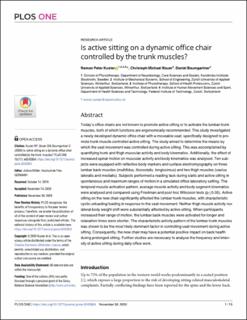Please use this identifier to cite or link to this item:
https://doi.org/10.21256/zhaw-21822| Publication type: | Article in scientific journal |
| Type of review: | Peer review (publication) |
| Title: | Is active sitting on a dynamic office chair controlled by the trunk muscles? |
| Authors: | Kuster, Roman Peter Bauer, Christoph Michael Baumgartner, Daniel |
| et. al: | No |
| DOI: | 10.1371/journal.pone.0242854 10.21256/zhaw-21822 |
| Published in: | PLOS ONE |
| Volume(Issue): | 15 |
| Issue: | 11 |
| Issue Date: | 2020 |
| Publisher / Ed. Institution: | Public Library of Science |
| ISSN: | 1932-6203 1932-6203 |
| Language: | English |
| Subjects: | Adult; Back Muscles; Biomechanical Phenomena; Electromyography; Female; Humans; Interior Design and Furnishings; Low Back Pain; Lumbosacral Region; Male; Middle Aged; Posture; Range of Motion, Articular; Spine; Young Adult; Ergonomics; Sitting Position |
| Subject (DDC): | 620: Engineering |
| Abstract: | Today's office chairs are not known to promote active sitting or to activate the lumbar trunk muscles, both of which functions are ergonomically recommended. This study investigated a newly developed dynamic office chair with a moveable seat, specifically designed to promote trunk muscle controlled active sitting. The study aimed to determine the means by which the seat movement was controlled during active sitting. This was accomplished by quantifying trunk and thigh muscular activity and body kinematics. Additionally, the effect of increased spinal motion on muscular activity and body kinematics was analysed. Ten subjects were equipped with reflective body markers and surface electromyography on three lumbar back muscles (multifidus, iliocostalis, longissimus) and two thigh muscles (vastus lateralis and medialis). Subjects performed a reading task during static and active sitting in spontaneous and maximum ranges of motion in a simulated office laboratory setting. The temporal muscle activation pattern, average muscle activity and body segment kinematics were analysed and compared using Friedman and post-hoc Wilcoxon tests (p≤0.05). Active sitting on the new chair significantly affected the lumbar trunk muscles, with characteristic cyclic unloading/loading in response to the seat movement. Neither thigh muscle activity nor lateral body weight shift were substantially affected by active sitting. When participants increased their range of motion, the lumbar back muscles were activated for longer and relaxation times were shorter. The characteristic activity pattern of the lumbar trunk muscles was shown to be the most likely dominant factor in controlling seat movement during active sitting. Consequently, the new chair may have a potential positive impact on back health during prolonged sitting. Further studies are necessary to analyse the frequency and intensity of active sitting during daily office work. |
| URI: | https://digitalcollection.zhaw.ch/handle/11475/21822 |
| Fulltext version: | Published version |
| License (according to publishing contract): | CC BY 4.0: Attribution 4.0 International |
| Departement: | School of Health Sciences School of Engineering |
| Organisational Unit: | Institute of Mechanical Systems (IMES) Institute of Physiotherapy (IPT) |
| Published as part of the ZHAW project: | T-CHAIR |
| Appears in collections: | Publikationen Gesundheit |
Files in This Item:
| File | Description | Size | Format | |
|---|---|---|---|---|
| 2020_Kuster_Is_active_sitting_on_a_dynamic_office_chair_PLOS_ONE.pdf | 776.7 kB | Adobe PDF |  View/Open |
Show full item record
Kuster, R. P., Bauer, C. M., & Baumgartner, D. (2020). Is active sitting on a dynamic office chair controlled by the trunk muscles? Plos One, 15(11). https://doi.org/10.1371/journal.pone.0242854
Kuster, R.P., Bauer, C.M. and Baumgartner, D. (2020) ‘Is active sitting on a dynamic office chair controlled by the trunk muscles?’, PLOS ONE, 15(11). Available at: https://doi.org/10.1371/journal.pone.0242854.
R. P. Kuster, C. M. Bauer, and D. Baumgartner, “Is active sitting on a dynamic office chair controlled by the trunk muscles?,” PLOS ONE, vol. 15, no. 11, 2020, doi: 10.1371/journal.pone.0242854.
KUSTER, Roman Peter, Christoph Michael BAUER und Daniel BAUMGARTNER, 2020. Is active sitting on a dynamic office chair controlled by the trunk muscles? PLOS ONE. 2020. Bd. 15, Nr. 11. DOI 10.1371/journal.pone.0242854
Kuster, Roman Peter, Christoph Michael Bauer, and Daniel Baumgartner. 2020. “Is Active Sitting on a Dynamic Office Chair Controlled by the Trunk Muscles?” Plos One 15 (11). https://doi.org/10.1371/journal.pone.0242854.
Kuster, Roman Peter, et al. “Is Active Sitting on a Dynamic Office Chair Controlled by the Trunk Muscles?” Plos One, vol. 15, no. 11, 2020, https://doi.org/10.1371/journal.pone.0242854.
Items in DSpace are protected by copyright, with all rights reserved, unless otherwise indicated.